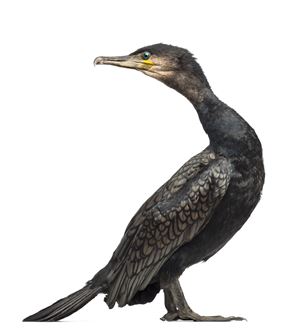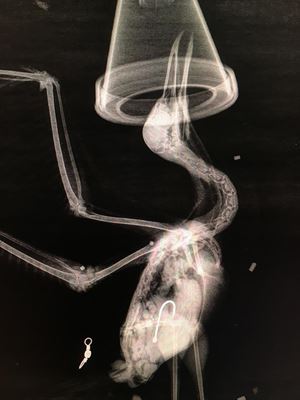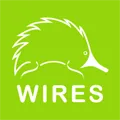Blog
Contact media@wires.org.au for enquiries or call 0416 272 153.
For the latest updates on bushfire recovery projects and emergency response
Read WIRES Emergency Recovery Plan and WIRES National Emergency Response Plan
Help us untangle this environmental mess.
While Sydney was preparing for another spectacular fireworks display, ‘Gal’ the Great Cormorant was fighting for her life. 
On New Year’s Eve WIRES rescuer Michaela and her husband found themselves abandoning their plans and jumping into a creek at a reserve in South West Sydney.
Michaela remembers seeing “a large bird that seemed to be drowning about five metres away from the shore. It was a Great Cormorant, completely exhausted and probably only minutes from death”.
Gal was entangled in metres of fishing line which was cutting into her left shoulder as it wrapped around her body multiple times. Michaela’s husband said that there were four different lines around her, two of which were attached to a float. He also found five fishing hooks attached to her body.
He was able to cut some line and get her to shore. The usually majestic and strong bird was coughing up water and was very weak.
“One of the fishing hooks had pierced through her beak and leg at the same time so she was not only in pain but she could barely move,” recalls Michaela.
Michaela and her husband travelled through Sydney, on what has to be the busiest night of the year, to reach an emergency vet.
Gal received antibiotics and stitches for two wounds on her left wing. One of the wounds was two centimetres wide, caused from the fishing line which had embedded into her skin.
The hooks were carefully removed from Gal’s body. The vet identified them as Treble hooks, which feature three barbs per hook. It is not uncommon for Seabirds to receive multiple wounds from these hooks, which dramatically decreases their chance of survival.
The strong-willed Cormorant recovered quickly and was successfully released back to the wild in the first week of January.
“When we left, there was still lots of fishing line in the water, including a float. Who knows how many hooks were under the water?” said Michaela, feeling frustrated at the cause of Gal’s injuries.
 Discarded recreational items such as fishing line, string and
plastics are creating multiple hazards for Australian wildlife. Fishing
line, like the one around Gal, does not biodegrade. It readily wraps
around the feet, legs, wings and even necks of animals, especially the
ones who inhabit coastal areas. These types of entanglements can cause
swelling and deep wounds. Animals including seabirds, raptors and
turtles can have these materials constricting or embedded into their
skin for weeks or months before being sighted and reported.
Discarded recreational items such as fishing line, string and
plastics are creating multiple hazards for Australian wildlife. Fishing
line, like the one around Gal, does not biodegrade. It readily wraps
around the feet, legs, wings and even necks of animals, especially the
ones who inhabit coastal areas. These types of entanglements can cause
swelling and deep wounds. Animals including seabirds, raptors and
turtles can have these materials constricting or embedded into their
skin for weeks or months before being sighted and reported.
The x-ray image is of a young seagull found on Sydney’s Bronte Beach. It was unable to fly and when WIRES rescuers arrived they believed it to have a broken wing caused by fishing line which had become wrapped around the bird’s body. A radiograph later confirmed it had swallowed a hook with a weight attached. The seagull couldn’t be saved.
WIRES’ teams are active all over NSW helping animals in similar situations. We can report that there were 1,382 entangled animals reported to WIRES in 2017. This is more than 3 animals every day.
Items which are tossed away, never to be thought of again, have huge consequences and our wildlife is paying the price. No species is immune to discarded waste which is causing pain and suffering to thousands of animals every year.
As marine debris and plastic pollution increases, so does the impact on wildlife. Help by sharing our infographic-Get Hooked on helping wildlife.
In 2015, National Geographic stated that plastic can be found in over 90% of Seabirds and research suggests that the number continues to climb.
WIRES rescuers are doing all they can to alleviate the pain and suffering caused by this situation but we need help. A gift today can allow us to invest more resources into rescuing and rehabilitating our native animals.
Search
Newsletter
Stay in touch and get our regular rescue stories, WIRES updates and a free copy of our 15 Ways to Help Wildlife ebook
Recent Posts
- Emergency Response Training for Wildlife Volunteers
- WIRES Introduces New Wildlife Rehabilitation Governance Courses in Collaboration with NPWS
- Community Support for Post-Bushfire Recovery of Wildlife in the Greater Blue Mountains
- Research Grants Program-2023 Recipients Announced
- National Koala Conference
- Nature Conservation Council's Bushfire Conference
- Support Stronger Nature Laws
- Helping Endangered Cockatoos: WIRES Grant Success Story
- Landmark Conservation Project Ensures The Future of The Northern Bettong
- Wildlife Road Collisions Unveiled
